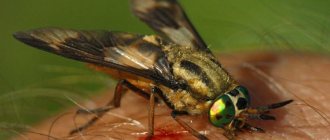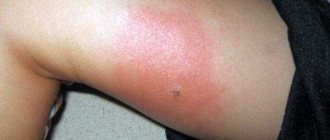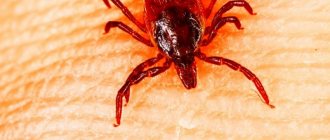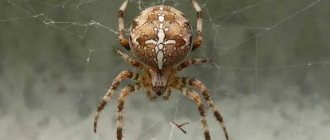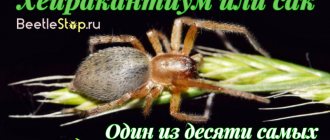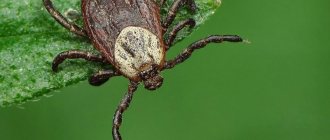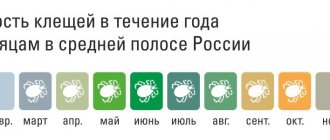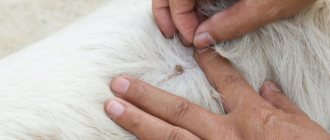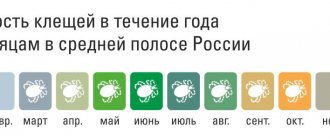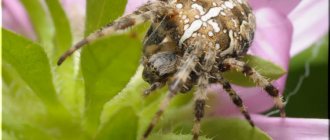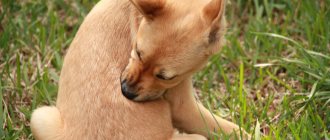On hot summer days, being outdoors, people are often attacked by various insects. In meadows or on the shores of water bodies, horseflies and gadflies are intrusive.
Although these insects are quite similar in appearance, they differ in the degree of invasion. The former drink blood, which they need to carry out the generative function, the latter lay eggs under the skin. Bloodsuckers can not only cause inconvenience, but also be carriers of dangerous diseases, since they bite both animals and humans.
From this article and the attached video, the reader will learn about how dangerous a horsefly bite is, what you can do on your own and when you need to see a doctor.
Papule at the site of a horsefly bite
Appearance Features
There are about 1,600 species of horseflies in nature. All of them are large in size - about 2 cm. The female is easy to distinguish by her large build, large iridescent eyes and the bridge between them.
The insect has an extremely complex oral apparatus. Powerful jaws, piercing, cutting, sucking components. Pierces the skin thanks to its fleshy, long proboscis.
The male's abdomen is pointed, the female's is rounded. Coloring in gray, brown dull tones. Large eyes are clearly visible, shimmering in the sun with all the colors of the rainbow.
Horsefly
Did you know that...
Horseflies are one of the fastest flying insects. They reach speeds of up to forty kilometers per hour ! In this case, the insect makes approximately 125 wing beats per second ! Therefore, it is not so easy to escape from them. Yes and there is no point. It is necessary to take other methods of defense that will scare off these aggressors in advance.
By the way, we included these insects in our TOP 10 most dangerous bites . You can view the full list here: The most dangerous insect bites - TOP 10 in Russia
By
Causes of bites
Flies go through several stages of development. The female lays a huge number of eggs, within a week larvae emerge from them, and from there pupae. And only then a big fly flies out.
It’s not hard to guess why horseflies bite – everything has to do with nutrition and reproduction. Only females are dangerous. They need blood to lay eggs and maintain vital forces. Without this component, the female will not be able to give birth to new offspring.
The diet is dominated by fresh blood of livestock and wild animals. But if a person appears in the field of view, the horsefly will not miss the moment. Males feed exclusively on flower nectar and do not live long. After fertilization, the females soon die.
Interesting!
One female is capable of laying from 500 to 1000 eggs. The first stage larvae develop on the host body. They are cattle, forest dwellers. The worms feed on blood and after a while fall into the grass, onto the soil, and pupate there. After a few days, it transforms into a fly.
Life cycle and reproduction
The life cycle of a horsefly includes four main stages:
- egg (the female lays from 400 to 1,000 pieces);
- larva;
- chrysalis;
- imago (adult).
The total duration of complete transformation is 4 years.
The method of reproduction of horse flies is similar to that of other dipterans. After mating, the female lays eggs on leaves and stems of plants, in water and moist soil.
The horsefly larva hatches in 3-8 days. This stage lasts about a year. In the spring, the larvae begin to pupate, having first moved to a drier place. This process may take several weeks. As a result, an adult horsefly is born.
When they bite
Flies are active during the daytime. They love sunshine and warm days. But among them there are representatives that parasitize in cloudy weather.
Insects react to movement and moisture. Attracts their wet, sweaty body. It is difficult to fight off horse flies after swimming in a pond, when your whole body glistens with droplets of water. They bite a wet body with beads of sweat even more intensely.
Horsefly bite What does a horsefly bite with - its proboscis and powerful jaws. The tenacious paws that dig into the skin add to the painful sensations. It bites anywhere on the human body. The neck and back are most often affected. In these areas, blood vessels are closer to the surface.
On a note!
The bite of a horsefly attracts other relatives to the victim. How horseflies bite is interesting not only to fauna lovers. In the process of piercing the vessels, the fly injects a substance that thins the blood and prevents it from clotting. After this, the wound bleeds for a long time, attracting hordes of new flies.
There are no parasites in urban areas, but if you go on a picnic or go to the country, there will be no end to the flies. To combat them, all kinds of traps and special insecticides are used, and the consequences of horsefly bites are treated in a special way.
Varieties
Currently, over 4 thousand species of horseflies are known. Often the characteristic features and lifestyle of an insect are indicated by its name:
- bullfly (one of the largest dipterous insects),
- deer horsefly,
- gray horsefly,
- ordinary raincoat,
- lacewing,
- forest lacewing, etc.
Gray horsefly
Signs of parasitism on the skin
You can see what a horsefly bite looks like in the photo. Symptoms in humans are unpleasant, painful, and can occur with varying degrees of intensity. Main symptoms:
- instant redness of the skin;
- burning, severe itching;
- pain at the site of the bite;
- prolonged bleeding;
- puffiness, swelling;
- When pathogenic microorganisms enter the wound, suppuration develops.
The reaction to a bite in children is much stronger; red spots are clearly visible on sensitive skin. An allergy to a bite in sensitive people is manifested by large-scale redness of the skin, an additional rash, severe swelling, and unbearable itching.
After a horsefly bite, it is recommended to wash the wound and disinfect it, but in the field this can rarely be done. For people with strong immunity, the consequences of a horsefly bite are not so terrible, while people with a tendency to allergies have to undergo special treatment. The horsefly bite in the photo is shown below; you can assess the scale of the problem.
Insect bite on human body
Basic information about horseflies
Horseflies are a type of midge (two-winged blood-sucking insects).
In total, there are about 4,000 species of such animals, 200 of which live in our area. The favorite habitats of horseflies are areas with abundant vegetation (forests, gardens, groves, crops in fields). But pests also thrive in urban environments. Compared to ordinary mosquitoes, horseflies are quite large blood-sucking insects. It is slightly larger than a regular fly. Horseflies have several stages of development. An interesting fact is that only female insects suck blood. Males feed on vegetation. At one time, the female sucks several times more blood than a mosquito.
You can distinguish a female by her appearance. Its body is almost 2 times larger in size than that of the male, its eyes are bulging, round, iridescent in multicolor. There is a bridge between the eyes.
Females feed on the blood of animals and humans. Without this food they will not be able to lay offspring.
The insect becomes active in the warm season. The largest number of parasitic flies is found in June-July. Horseflies love sunny, windless weather. You can't see them in rain or hurricanes. Parasites look for their victims based on two main signs - moisture and the smell of sweat. Insects have very developed jaws located in the proboscis. They use them to gnaw through the skin of a person or animal to extract blood. It is surprising that they sense the proximity of blood vessels. And they sting most often in those places where the skin is thinner and the capillaries are close to the surface.
There are cases where the parasite has bitten the eye (eyelid), head, or lip.
The area after a horsefly bite is always red. The bite itself is also sensitive. Only a sleeping person can fail to notice it. Sometimes people mistake horseflies for ordinary flies and do not pay attention. In a short time, the parasite manages to choose a victim and tries to sting as quickly as possible.
On a note! Externally, horseflies are very similar to gadflies. But unlike the former, gadflies do not suck blood, but can deposit their larvae under a person’s skin.
Severe consequences
An attack by a large fly is dangerous not only due to unpleasant sensations, skin damage, allergic reactions, but also terrible diseases. Insects are carriers of many diseases. Animals and humans can become infected with tularemia, filariasis, anthrax, and trypanosomiasis. You can get rid of horse flies using various means and traps.
If, in addition to the symptoms described above, there is a significant deterioration in health, body temperature rises, and the bite site swells, you must seek help from specialists, undergo an examination, and do not self-medicate.
Important!
In most cases, a horsefly bite goes away within a week, and the itching disappears within a few days. What to do if bitten by a horsefly, do not panic. Try to quickly treat the wound with an antiseptic, wipe with any alcohol tincture. Further actions depend on the condition of the skin and the body’s reaction.
Prevention
In nature, you need to carefully monitor children, because they are often attacked by insects
You can protect yourself from annoying insects using repellents applied to the skin. When outdoors, it is recommended to cover exposed areas of the body with clothing. You should not sleep on the grass or in the forest; mosquito nets should be installed on windows and doors.
It is important to remember that it is quite difficult to avoid horsefly bites, but if you are careful, you can prevent this. The surest way to attack an insect is to try to kill it.
Emergency therapy
Emergency care for a bite An infection gets into the open wound, which complicates the situation even more. Constant scratching is dangerous due to the addition of a secondary infection. In serious situations, local antibiotics must be used. But if everything is done correctly, you can avoid terrible complications.
- If you are bitten by a horsefly, you need to disinfect the wound as quickly as possible and stop the bleeding.
- In the field, the affected area is lubricated with saliva. But it is better to wipe the bite with any product containing alcohol.
- Another way to treat horsefly bites is to rinse the wound with clean running water. And even better with the addition of laundry soap. It is recommended to lather the sore area, leave for a few minutes, and rinse.
- How to treat swelling - apply a cold object to the affected area. At home, you can use ice and frozen meat. In the field - a bottle of drink, ice cream, cold water.
- If your hand is swollen or your temperature rises, this indicates an allergic reaction. In this case, a product containing antihistamine components is recommended. Fenistil gel, which can be found at any pharmacy on the way home, will help relieve swelling from a bite. If your leg is swollen, Zvezdochka balm, which contains more than 20 medicinal components, also helps.
- To prevent the bite from itching, the wound must be disinfected or a soda paste applied. Dilute baking soda with a small amount of water and apply it to the affected area for a few minutes. You can also anoint the horsefly bite with toothpaste containing mint ingredients.
- In the field, they will help cope with unpleasant symptoms and plant tumors. If a horsefly bite itches, you should smear the skin with the juice of dandelion, celandine, and plantain. The last component can be applied to the wound for a while.
- Lemon juice or a slice of citrus fruit will help disinfect the wound, prevent swelling, and stop itching.
- A solution of hydrogen peroxide or a concentrated preparation helps well.
How to treat a horsefly bite depends on the complexity of the situation. A terrible allergic reaction can be stopped by antihistamines that are taken orally and lubricate the skin.
For immediate relief of unpleasant symptoms, hormonal drugs are prescribed. Among them is Advantan, which can be used in children after 6 months. Not only the affected area can swell, but also the larynx with severe allergies. Then emergency medical assistance is required.
Remedies for horsefly bites:
- tincture of calendula, valerian, motherwort;
- potato gruel or juice;
- onion juice;
- garlic decoction;
- Valocordin;
- Corvalol;
- tea tree oil;
- aloe juice;
- propolis tincture.
If you treat the wound correctly and prevent infection, the consequences will go away as quickly as possible without complications.
What kind of insect is a gadfly and what does it look like?
Another name for the gadfly is paut, which is what these flies used to be called in the northern regions.
The more common name is string, and the origin of all these words still remains a mystery to lexicographers. Botflies belong to the order of Diptera and the infraorder of round-stitched flies. Their closest relatives are blowflies and true flies. To date, entomologists have described about 150 species of gadflies, all of them are typical synanthropes, i.e., their habitats are closely related to human life.
Gadflies are distributed throughout the globe, they are not found only in Antarctica. The inhabitants of temperate latitudes resemble an ordinary fly in appearance, but slightly larger in size. The size of an adult gadfly is about 17-20 mm. The insect has a fuzzy abdomen and translucent wings with veins.
A distinctive feature is large eyes, but the horsefly, with which the gadfly is often confused, has even larger eyes and is larger. The differences between the insects are clearly visible in the photo of the gadfly and the photo of the horsefly.
Horsefly with sucker on nose; Gadflies do not have such a sucker.
Gadflies from the northern regions are painted in discreet tones: dark brown, lead-gray and grayish-blue specimens are found.
Southern and tropical species of gadflies, with their orange-striped color, are more reminiscent of medium-sized bumblebees.
These flies are not interested in cows, horses and humans as food objects; the adults do not eat at all, but use up the reserves accumulated in the larval stage. But the biology of parasites is such that they are able to develop normally only within certain species of animals.
One of the types of gadflies. One of the types of gadflies.
Treatment of parasitic infection caused by gadfly
An infectious disease specialist is responsible for ridding a person of parasites. A visual examination and an enzyme-linked immunosorbent blood test can confirm or refute infection with a gadfly larva.
If the test is positive, a gastroenterologist, ENT specialist, ophthalmologist and other specialists are involved in treatment, depending on the location of the parasites.
The patient is prescribed a course of antibiotics and antiparasitic drugs. Subcutaneous larvae are removed medically or surgically.
Everyone is at risk of infection by the parasitic fly, which is widespread everywhere, but especially those living or staying in areas where livestock farming is developed. Therefore, you should not ignore basic protective measures.
What you need to know
The overwhelming majority of people cannot accurately distinguish a horsefly (large, often with multi-colored eyes playing with colors) from a gadfly (smaller, less bright), and the assistance that should be provided to the victim depends on this. There are more than 3.5 thousand varieties of large flies that attack humans and mammals.
Most are classified as horseflies (3000 species) and gadflies (50 species). They are quite similar, so at first glance it can be difficult to determine exactly which particular insect this is, even for an experienced biologist.
Subcutaneous botfly - more often causes invasion in humans than other species
Important. The fundamental difference between horseflies and gadflies is that the former feed on blood, while the latter lay eggs under the skin of warm-blooded animals.
Only females always bite. If she manages to lay a clutch, then after a short period of time the larvae begin to hatch under the epidermis.
The duration of the infestation may vary, depending on the type of insect. For humans, the danger is posed by the subcutaneous gadfly (see photo), in this case it lasts about two months - all this time the larvae will parasitize and cause severe discomfort.
Most often, laying does not occur due to noticeable pain at the time of piercing the skin, but in certain cases (deep sleep, intoxication, the inability of a person (for various reasons) to drive away an insect, etc.) the eggs still end up under the skin.
All other types of gadflies are not so dangerous for humans, except in cases where the larvae end up in the eyes, which can cause the development of conjunctivitis and deterioration of the visual analyzer; in special situations, treatment even requires surgical intervention. Most of all, insects bother large warm-blooded animals, but sometimes small rodents also suffer. The larvae infect various organs, and when they accumulate in large numbers in the body, they cause the death of the infected individual.
